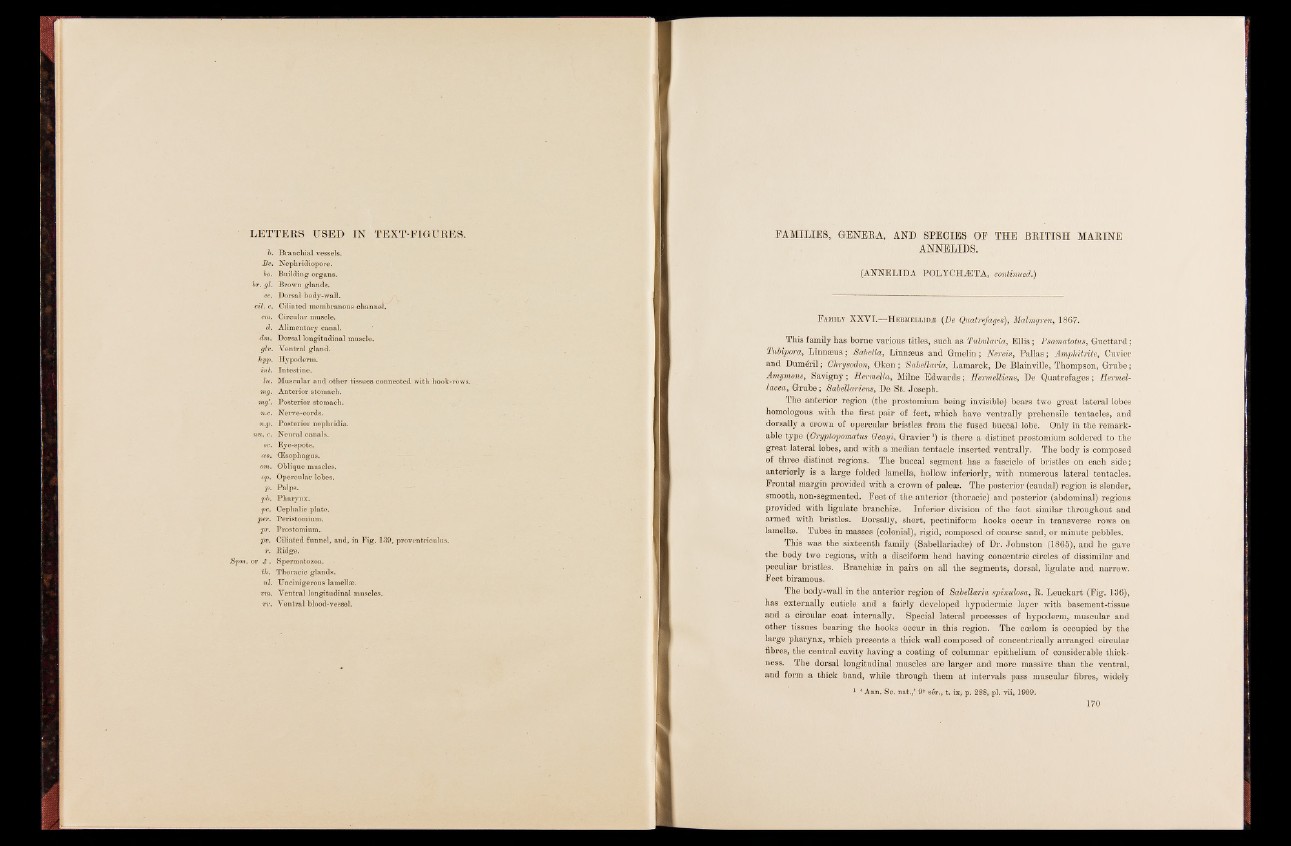
LETTERS USED IN TEXT-FIGURES,
b. Branchial vessels.
Be. Nephridiopore.
bo. Building organs.
br. gl. Brown glands.
cc. Dorsal body-wall.
cil. c. Ciliated membranous channel.
cm. Circular muscle.
d. Alimentary canal.
dm. Dorsal longitudinal muscle.
glv. Ventral gland.
hyp. Hypoderm.
int. Intestine.
lu.
mg.
■ mg'.
n.c.
n.p.
nu. c.
oc.
ces.
om.
op.
pPb-.
pc.
pei'.
pr.
pv.
r.
Bpm. or S .
th.
til.
vm.
vv.
Muscular and other tissues connected with hook-rows.
Anterior stomach.
Posterior stomach.
Nerve-cords.
Posterior neplmdia.
Neural canals.
Eye-spots.
(Esophagus.
Oblique muscles.
Opercular lobes.
Palps.
Pharynx.
Cephalic plate.
Peristomium.
Prostomium.
Ciliated funnel, and, in Fig. 139, proventriculus.
Ridge.
Spermatozoa.
Thoracic glands.
Uncinigerous lamellae.
Ventral longitudinal muscles.
Ventrai blood-vessel.
FAMILIES, GENERA, AND SPECIES OF THE BRITISH MARINE
ANNELIDS.
(ANNELIDA POLYCHÆTA, continued.)
F amily XXVI.—H ermellid.® {De Quatrefages), Malmgren, 1867.
This family has borne various titles, such as Tubularia, Ellis; Psamatotus, Guettard;
Tubipora, Linnasus; Sabella, Linnseus and Gmelin; Nereis, Pallas; AmphitHte, Cuvier
and Dumeril; Ghrysodon, Oken; Sabellaria, Lamarck, De Blainville, Thompson, Grube;
Amymone, Savigny; Hermella, Milne Edwards; Hermelliens, De Quatrefages; Hermel-
lacea, Grube; Sabellariens, De St. Joseph.
The anterior region (the prostomium being invisible) bears two great lateral lobes
homologous with the first pair of. feet, which have ventrally prehensile tentacles, and
dorsally a crown of opercular bristles from the fused buccal lobe. Only in the remarkable
type (Cryptopomatus Geayi, Gravierx) is there a distinct prostomium soldered to the
great lateral lobes, and with a median tentacle inserted ventrally. The body is composed
of three distinct regions. The buccal segment has a fascicle of bristles on each side;
anteriorly is a large folded lamella, hollow inferiorly, with numerous lateral tentacles.
Frontal margin provided with a crown of palese. The posterior (caudal) region is slender,
smooth, non-segmented. Feet of the anterior (thoracic) and posterior (abdominal) regions
provided with ligulate branchiae. Inferior division of the foot similar throughout and
armed with bristles. Dorsally, short, pectiniform hooks occur in transverse rows on
lamellae. Tubes in masses (colonial), rigid, composed of coarse sand, or minute pebbles.
This was the sixteenth family (Sabellariadae) of Dr. Johnston (1865), and he gave
the body two regions, with a disciform head having concentric circles of dissimilar and
peculiar bristles. Branchiae in pairs on all the segments, dorsal, ligulate and narrow.
Feet biramous.
The body-wall in the anterior region of Sabellaria spinulosa, R. Leuckart (Fig. 136),
has externally cuticle and a fairly developed hypodermic layer with basement-tissue
and a circular coat internally. Special lateral processes of hypoderm, muscular and
other tissues bearing the hooks occur in this region. The coelom is occupied by the
large pharynx, which presents a thick wall composed of concentrically arranged circular
fibres, the central cavity having a coating of columnar epithelium of considerable thickness.
The dorsal longitudinal muscles are larger and more massive than the ventral,
and form a thick band, while through them at intervals pass muscular fibres, widely
1 f Aim. Sc. nat./ 9e ser., t. ix, p. 288, pi. vii, 1909.